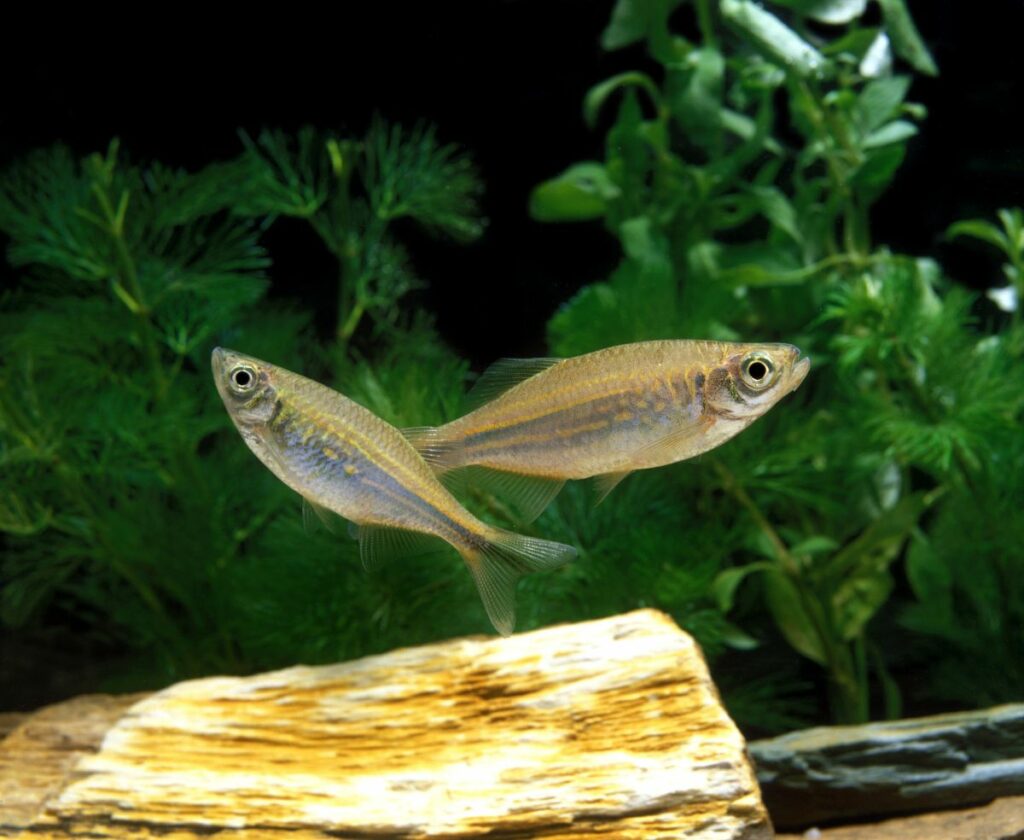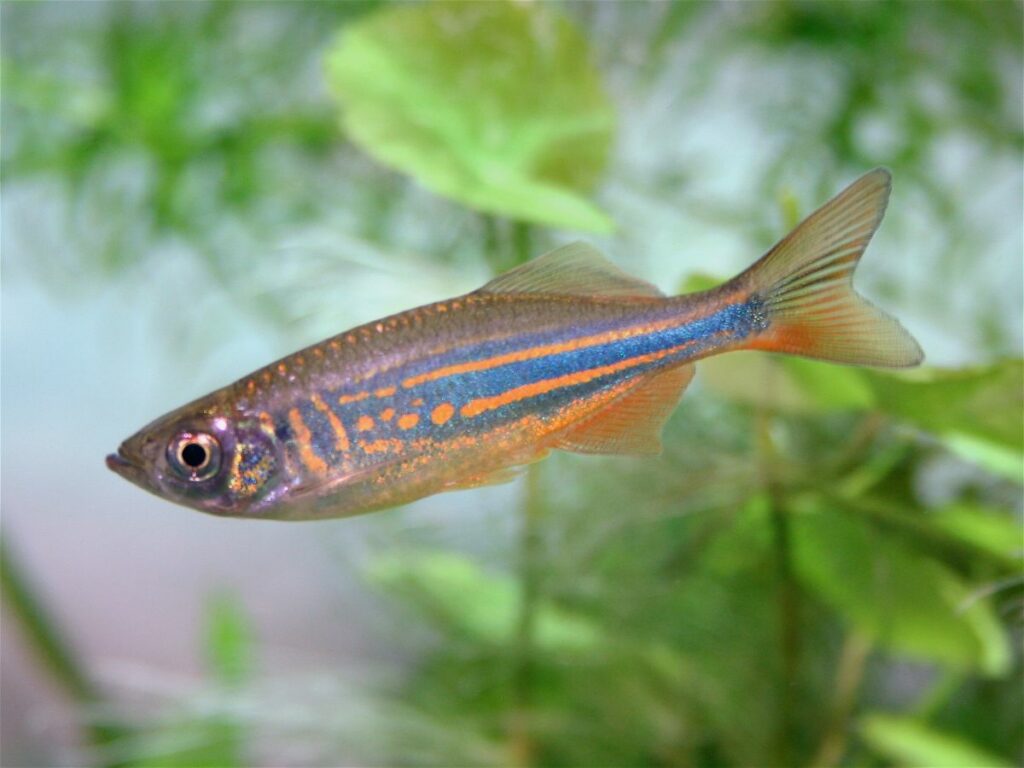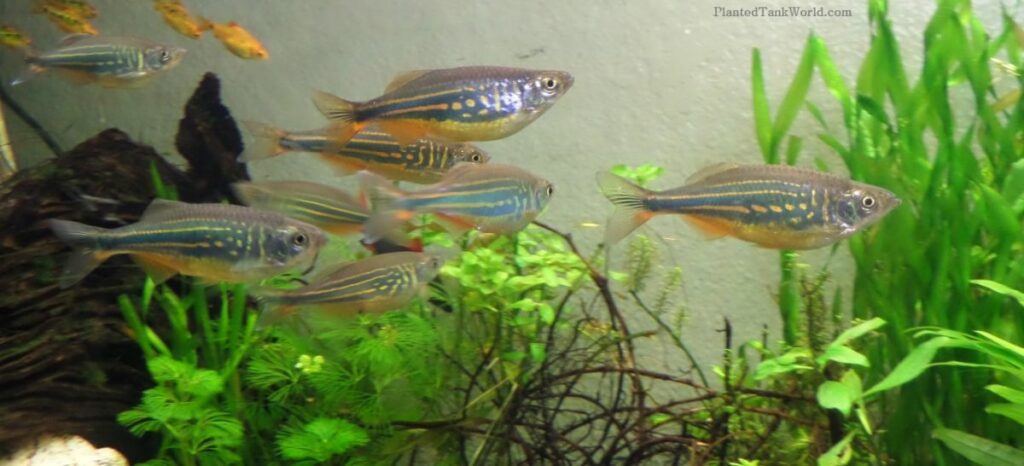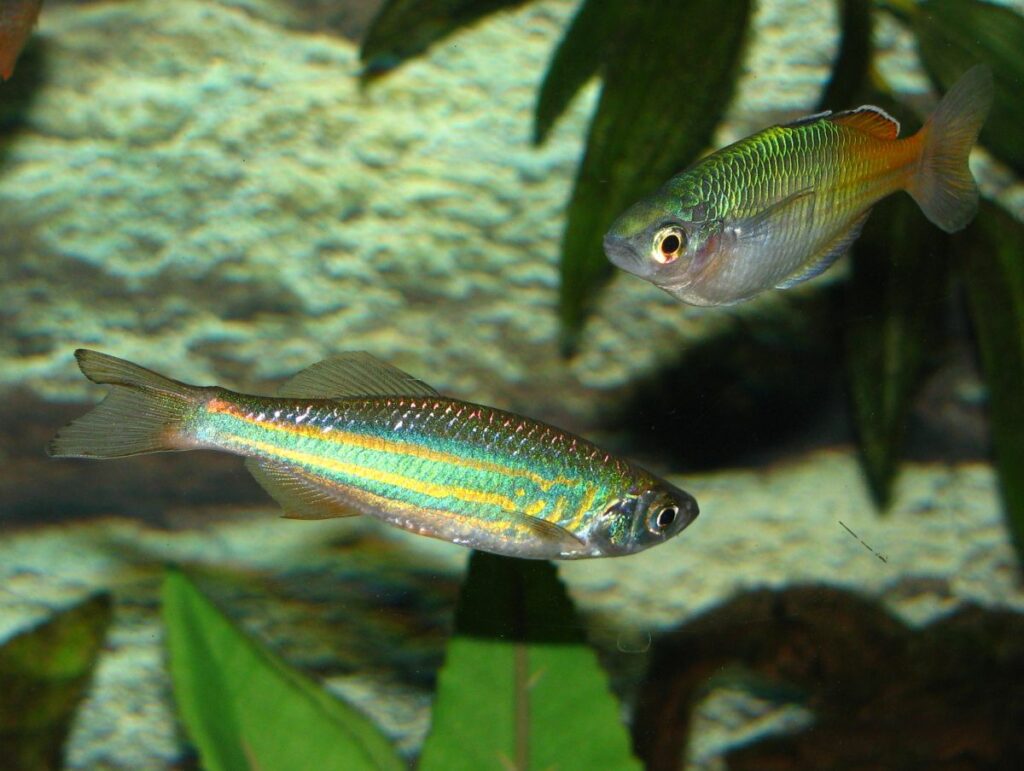Giant Danio fish are the second most popular species of danio after the Zebra Danio (Danio rerio). Most are small fish that don’t grow any larger than 1 or 2 inches. But the Giant Danio lives up to its name, growing as long as 4, or even 6 inches.

Like all danios the Giant Danio is a hardy aquarium resident and undemanding when it comes to water conditions like temperature or chemistry. Giant Danio lifespan is also generous; they live five to seven years in ideal conditions.
Getting to Know the Giant Danio
As medium-sized aquarium fish, Giant Danios are a solid addition to community tanks of similarly sized fish. They do have a semi-aggressive nature, however.
Small fish are likely to be picked at or even eaten. Slow moving fish with long fins might be picked at as well. So all tank mates need to be chosen with care.
There is another fish that looks almost identical to the Giant Danio: the Malabar Danio (Danio malabaricus). It can be hard even for expert aquarists to tell the difference between the two species.
Malabar Danios are very rare in pet stores, however. Even specialty stores will have trouble finding them. Any time a few Malabar Danios get imported they will be labeled as such. They will be pricier than common Giant Danios.
- Common Name: Giant Danio, Golden Danio, Malabar Danio
- Scientific Name: Danio aequipinnatus (Danio malabaricus as well but it is a different species)
- Origin: South Asia (Sri Lanka, Nepal, India)
- Length: 4 to 6 inches
- Aquarium Size: 40+ gallons
- Temperament: Semi-aggressive
- Ease of Care: Very Easy
Giant Danio Care
Large aquarium fish can sometimes intimidate new fish keepers. But the Giant Danio is an undemanding and easy to keep fish. Just make sure that you have enough space since they are very social creatures.

Giant Danio Tank Size
Giant Danio size is more impressive than their smaller relatives. That said, they are just as active, speeding around the aquarium with lightning-quick motions. So you will need a spacious aquarium to keep them from slamming into the sides when startled.
For such large fish Giant Danios are often skittish. Turning on the lights too fast can cause them to leap in confusion. They are too fast to be caught by aggressive tank mates. But a Great Danio might be so startled that they run into decorations or the glass.
An aquarium at least 40 gallons in volume is required since you also need to Giant Danios them in groups of six or more. A 55 gallon fish tank is even better, however. The length of the tank gives your Giant Danios plenty of space to school and roam.
Space is important – but a secure lid also matters. Even if they aren’t scared Giant Danios will sometimes leap in nature for their own reasons. Without a strong lid you might find one or more on the floor one day.
Plants and Aquascaping for Giant Danio Fish
Aquariums full of live plants are ideal for a Giant Danio group. Plants provide shade and shelter, helping these nervous fish feel more secure. If you can add floating plants to your set up, you will discourage them further from jumping.
Plants also use ammonia, nitrite, and nitrate as fertilizer, sucking up these pollutants as a source of nitrogen. Enough plants will act as a secondary biological filtration system for your aquarium.
And as egg scatterers, you will find Giant Danio eggs stuck to plant tangles if they ever breed for you. Danios prefer Guppy Grass, Hornwort, and other weedy aquatic plants to lay their eggs in. These fish are entirely carnivorous as well so they won’t eat or uproot plants you add to the aquarium.
Water Conditions for Giant Danios
All danio fish are not picky when it comes to water conditions. They do prefer slightly cooler water than many tropical fish. 72-75°F is the preferred water temperature range. Giant Danios can live in warmer water but it’s a little stressful for them. Cooler water also holds more oxygen, which these active fish need.

Even if your water is not too warm I recommend adding extra aeration in the form of a bubble wall. You can also set up the filter outflow to splash, disturbing the surface enough to oxygenate the water. Live plants also provide oxygen through photosynthesis.
Water chemistry is not too important so long as you avoid the extremes. Giant Dino fish prefer conditions that are only a little acidic or alkaline (pH 6.5 to 7.5). Bringing the chemistry as close to neutral as possible is the goal. Water hardness is also unimportant so long as extreme hardness or softness are avoided.
Best Food for Danio Fish
Giant Danios are carnivorous fish that live mostly near the surface. They feed on insects that breed on or get stuck at the water’s surface. Mosquito larvae and blood worms are favorites of theirs. They also love worms, baby shrimp, fish fry, and any other tiny animals they can swallow.
That said, they are not at all picky and will eat any flake or pellet food that you offer. Pellets should be presoaked if they are hard since Giant Danios don’t have teeth to chew them properly.
Supplement their diet regularly with frozen foods and live foods as well. Some good choices include brine shrimp and tubifex worms since prepared foods can lack essential nutrients. These foods are also rich in healthy fats.
Giant Danio Tank Mates
Giant Danio tank mates should be chosen with care as these fish can be semi-aggressive. It’s often a lone Giant Danio with none of its own kind around that turns into a fin nipper.
By keeping them in a Giant Danio group the fish will focus most of their attention on chasing one another instead of their tank mates.
Six is the minimum number of Giant Danios you should keep. Any fewer and they will become skittish and unwilling to be out in the open. These fish live in schools of hundreds to thousands in the wild. Too few is a sign that there are predators lurking nearby and they should hide.
Giant Danios are popular dither fish for medium and large aquarium fish community tanks. Since they can grow nearly 6 inches long, many predatory fish find them too big to eat. Medium sized cichlids like Jack Dempsey fish can be kept with Giant Danios to provide some extra activity and color.
But some large cichlids will still be able to eat a full grown Giant Danio. Oscars, Peacock Bass, Arowanas and other fish predators are not a good match once they reach adult size.
Guppies, Zebra Danios, Tetra fish, and other small fish are also a bad match. The Giant Danios will likely bully or even eat their smaller tank mates.
The best tank mate choices are medium sized fish like Gouramis, Killifish, and many cichlids. Keyhole Cichlids, Freshwater Angelfish, Severums, and Convict Cichlids are all just the right size.
Giant Danio Breeding
Since their care is so uncomplicated you’d be right to suspect Giant Danio breeding is not difficult, either. As long as you have males and females together and are feeding them a rich, nutritious diet, you will see the females swell with eggs.

The differences in size are subtle but obvious once the females are pregnant. Full grown Giant Danio females can be an inch longer than their mates. But if they aren’t full grown then it may be harder to sex them. Males are slimmer than females but only by a little.
Male Giant Danios also spend a lot of their time chasing females that are full of eggs and competing with rival males.
As egg scatterers Giant Danios need a place to deposit their small, sticky eggs. If you don’t have any live plants you can use plastic plants. Spawning mops are also a good option: durable synthetic thickets of plants that are easy to add and remove.
You should remove the eggs, by the way. Like most egg scatterers Giant Danios will forget about their young in a few hours. They then see them as a source of food and will eat any eggs and fry they later find.
Giant Danio eggs will hatch in 24 to 48 hours and the fry need very small live foods their first week. I recommend starting an infusoria culture when you see your female start to ripen with eggs.
After the first week the fry should be large enough to eat baby brine shrimp nauplii and other small live foods.
Conclusion
Giant Danio fish are flashy, active, and large. They are also hardy and long-lived pets and offer a bold addition to medium and large community fish tanks. Just make sure your aquarium lid is secure and you offer them plant thickets to spawn within.
More Frequently Asked Questions About Giant Danio Care
Great Danio care is uncomplicated but maybe you have a few more questions about these lively cyprinids? In that case, here are some frequently asked questions about Giant Danios answered by me.
Danios, including Giant Danios, are not livebearing fish. Livebearers are a group of unrelated fish found entirely in North and South America. Giant Danios are cyprinids and egg scatterers from South Asia.
When buying a Giant Danio group six fish is the minimum number you should have. Fewer fish is stressful to them since they are missing the school that keeps them safe. If you have space you should always buy more Giant Danios to keep each other company.
Giant Danios are semi-aggressive. They will pick at smaller tank mates as well as long finned aquarium fish. So choose medium sized fish that are either fast moving or semi-aggressive as well. Peaceful fish that are larger will also be ignored.

